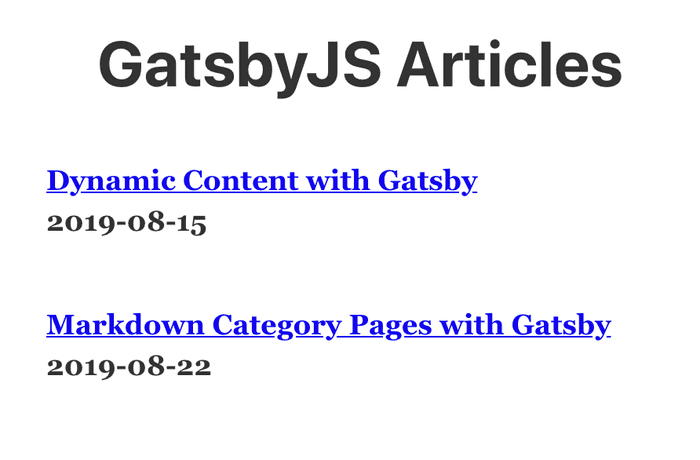This article contains a strategy for creating category list pages from categories defined in a markdown article. There is an assumption of some basic knowledge of gatsby.
Our end goal is to generate the pages /category/GatsbyJS and /category/React which both lists links to any articles within the category. For example, for a "GastbyJS" category we want to generate a list of articles
Markdown Frontmatter
To categorize our articles we are going to include a property in our frontmatter called categories, which is an array of categories that the article belongs to.
# src/articles/gatsby-categories.md
---
title: Markdown Category Pages with Gatsby
slug: gatsby-categories
categories: ["GatsbyJS", "React"]
date: "2019-08-01"
---
This strategy is for creating category list pages from categories defined in markdown frontmatter...We are going to skip over the generating of the article pages themselves, the Gatsby tutorials have a section on that or you can copy from the CodeSandbox embed at the bottom of this article.
Gatsby Configuration
In the gatsby-config.js file you should have gatsby-transformer-remark included in your plugins with gatsby-source-filesystem pointing to the location of your markdown files.
// gatsby-config.js
module.exports = {
plugins: [
{
resolve: `gatsby-source-filesystem`,
options: {
name: `articles`,
path: `${__dirname}/src/articles`,
},
},
`gatsby-transformer-remark`,
],
}All of our articles will go into the src/articles directory with the frontmatter format including title, slug, categories and date.
gatsby-node.js is the file where we write code to generate our static pages. First, let's create a utility function that is going to do most of the work, it iterates over all of our articles and builds an array that only contains one of each category.
// gatsby-node.js
function dedupeCategories(allMarkdownRemark) {
const uniqueCategories = new Set()
// Iterate over all articles
allMarkdownRemark.edges.forEach(({ node }) => {
// Iterate over each category in an article
node.frontmatter.categories.forEach(category => {
uniqueCategories.add(category)
})
})
// Create new array with duplicates removed
return Array.from(uniqueCategories)
}Then we are going to make use of the dedupeCategories function to generate our category pages.
// gatsby-node.js
exports.createPages = async ({ graphql, actions, reporter }) => {
const { createPage } = actions
// Query markdown files including data from frontmatter
const {
data: { allMarkdownRemark },
} = await graphql(`
query {
allMarkdownRemark {
edges {
node {
id
frontmatter {
categories
slug
}
}
}
}
}
`)
// Create array of every category without duplicates
const dedupedCategories = dedupeCategories(allMarkdownRemark)
// Iterate over categories and create page for each
dedupedCategories.forEach(category => {
reporter.info(`Creating page: category/${category}`)
createPage({
path: `category/${category}`,
component: path.resolve("./src/templates/CategoryList.js"),
// Create props for our CategoryList.js component
context: {
category,
// Create an array of ids of articles in this category
ids: allMarkdownRemark.edges
.filter(({ node }) => {
return node.frontmatter.categories.includes(category)
})
.map(({node}) => node.id),
},
})
})In src/templates/CategoryList.js a file that we referenced in the createPage function call we can use the article ids to generate the list of links to our articles and use the pageContext prop to get the category name.
// CategoryList.js
import React from "react"
import { Link, graphql } from "gatsby"
const CategoryList = ({ pageContext: { category }, data: { allMarkdownRemark } }) => (
<div>
<h1>{category} Articles</h1>
<ul>
{allMarkdownRemark.edges.map(({ node }) => {
return (
<li key={node.frontmatter.title}>
<Link to={`article/${node.frontmatter.slug}`}>{node.frontmatter.title}</Link>
<div>
<time>{node.frontmatter.date}</time>
</div>
</li>
)
})}
</ul>
</div>
)
export const query = graphql`
query CategoryListQuery($ids: [String]!) {
allMarkdownRemark(filter: { id: { in: $ids } }) {
edges {
node {
frontmatter {
slug
title
date(formatString: "MMM D, YYYY")
}
}
}
}
}
`
export default CategoryListThere you have it! we have category list pages being generated at build time in gatsby. Next up you just need to figure out how you want to link users to those category pages, maybe each post has a tag that the user can click on or your home page has a list of categories. Heres a full example on CodeSandbox with both the category list and article pages generated, with the homepage linking to each category.
